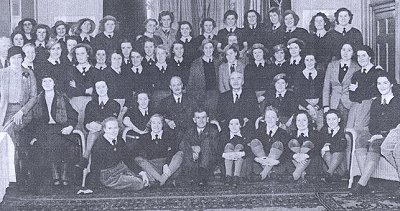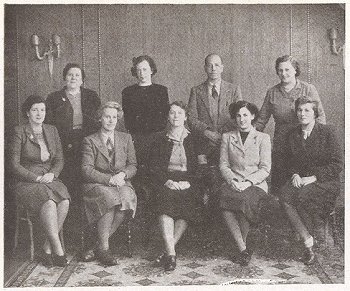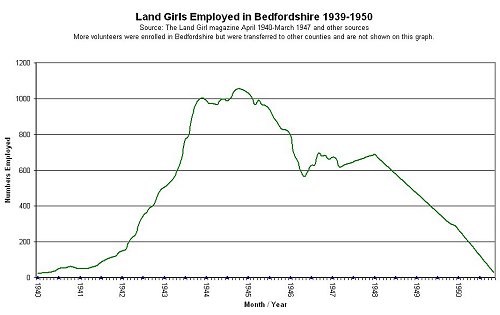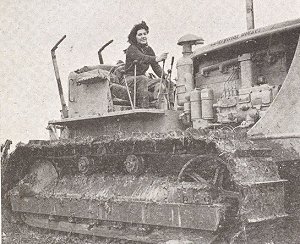Bedfordshire Women's Land Army
during and after the Second World War
Bedfordshire Women's Land Army
Lady Denman, who directed the Women's Land Army (WLA) throughout the Second World War, and planned its structure on county committees, appointed Mrs Nora Whitchurch as Chairman of the Bedfordshire WLA and Miss G.M. Farrar as Honorary Organising Secretary. When the WLA officially started in June 1939, it set about its work. First it contacted farmers in the county to establish who might need what help in the way of relief labour.
The next step was to seek billets in the neighbourhood of those farms, as soon as the need to accommodate volunteer land girls became known. These young women were asked to make agriculture their wartime occupation, to take over from the experienced male farm workers as they were gradually called up into the armed forces or left for better-paid war work.
The county headquarters was initially at 2 St. Paul's Square, in the area of Shire Hall. By November 1941 Mrs Erica Graham, wife of the Clerk to the County Council, had taken over from Mrs. Whitchurch. In November 1941 Mrs Lois Heydeman was appointed the salaried County Secretary, appointed by the WLA national Headquarters, at Balcombe Place, Haywards Heath, West Sussex.

Swan Hotel reception for Land Girls, October 1941
Bedfordshire's WLA's HQ office moved in June 1942 to 43 Harpur Street, where it remained for the rest of the life of the county office (in November 1949 the Bedford office closed and its responsibilities for Bedfordshire WLA passed to the Buckinghamshire HQ, as membership numbers, post-war, had fallen to a few hundred). The WLA's emblem, the sheaf of corn, formed a sign above the door to the office (now the site of the Eagle Court building), which was shared with the Ministry of Food.
In March 1943, Mrs Heydeman resigned, due to ill-health, and her Assistant Secretary, Mrs Ida Eugster, took over and was County Secretary until November 1949, when the office closed.

Beds WLA HQ Office Staff 1946
Only a handful of volunteers were signed up in 1939 (only 24 were serving by 31 December 1939, 53 by December 1940 and 140 by December 1941. Minimum pay for land girls, for a 50 hour working week in summer and 48 hours in winter (minimum age 17 years) was only 28 shillings (1.40p) per week, with 14 shillings (70p) deducted for board and lodging) less than half the national average for unskilled labour in other occupations, and 10 shillings (50p) a week less than male agricultural workers.
The introduction of conscription for large numbers of women, following the National Service Act of November 1941 led in early 1942 to much larger numbers volunteering for the Land Army. Young women had the choice of either joining the armed forces (WRAAF, WRENS or ATS) or doing war work in factories (such as producing munitions) or working on the land and becoming Land Girls. By 1942 all unmarried women between the ages of 19 and 30 were required to undertake war work.
As a result, Bedfordshire WLA had 506 land girls by December 1942 and 792 in July 1943. Employment numbers reached their peak in the county 1006 paid "volunteers" - in December 1943. The other key difference, from 1942 onwards, was that increasing numbers were being employed directly by Bedfordshire "War Ag" (Bedfordshire War Agricultural Executive Committee, or WAEC), housed in hostels around the county, and transported daily to surrounding farms, according to the seasonal needs of the farmers. Large numbers of recruits were from London, Essex and the northern counties of England, especially from the Yorkshire mill towns.

Roughly half of the land girls working in Bedfordshire were employed directly by private farmers and employed only on their farms. These land girls were often drawn from the county itself, including the large market towns and the industrial centres of Bedford and Luton (then part of Bedfordshire). The other fifty per cent of Bedfordshire's land girls shared life in hostels set up by the "War Ag" but often run by the YWCA (Young Women's Christian Association) under a Warden. These hostels housed large groups of Land Girls (the average size was 40 in huts but ran from small houses with as few as 16 up to large country mansions such as at Cople, housing up to 100. Hostel girls benefited from the company and support of other land girls both when working and during their time off, whereas life could be very lonely and isolated for single land girls working on private farms.
There were seventeen residential hostels, including three training centres at Luton Hoo, Toddington Park and Ravensden, where land girls attended for 4-week sessions of induction training in milking, arable work and animal husbandry before being sent to work either on a private farm or to a hostel. Many land girls had to train on the job, on their farms, but there were opportunities, later, to learn to drive tractors or do some specialist training and pass tests to achieve proficiency certificates.
Farmers were set almost impossible challenges during the war. On the one hand they lost their most experienced workers as the needs of war dictated they be used elsewhere (farming became less of a "reserved occupation" as the war progressed) and more was required of them in terms of agricultural output. Bedfordshire War Ag. (Beds WAEC) set Bedfordshire farmers a target of 10,000 new acres to be ploughed up during 1940. Amazingly, they achieved 17,000 new acres of arable land. Reclamation of previously uncultivated land was helped by the introduction of caterpillar tractors and other agricultural machinery from America, thanks to the Lend-Lease arrangement. Bedfordshire War Ag. was able to loan machinery to farmers who could not afford to buy their own. Increasingly, land girls became the expert mechanics on the farm. Although 'lumber jills' served in the Timber Corps in some of the surrounding counties, research has not yet revealed any significant Bedfordshire presence.

Caterpillar tractors enabled uncultivated land to be reclaimed.
At the beginning of the war, 2/3 of Britain's food was imported from around the world but war, and the enemy's blockage of our merchant shipping, forced Britain to "dig for victory" and turn that situation around. By the end of the war, 2/3 of Britains food was produced at home and only 1/3 needed to be imported. The role of Bedfordshire's land girls, as elsewhere around the country, was vital in achieving that increasing self-sufficiency.
Stuart Antrobus Historian/Author
Page last updated: 10th March 2014

